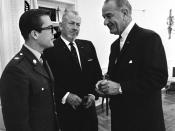As you know, women have often been portrayed as the weaker sex when compared to men but do not ask me why. It's been like that throughout the history of mankind. As a result of these assumptions, many women have been bravely trying hard to dissociate themselves from this frame of mind and become more independent with their lives. When John Steinbeck's short story "The Chrysanthemums" first appeared in the October 1937 edition of Harper's Magazine, Franklin D. Roosevelt had just been re-elected president of the United State of America. The country was recovering from the Great Depression, unions were developing, and child labour in manufacturing was terminated (Jones 805-6). The first female cabinet member in American history, Frances Perkins, was appointed the Secretary of Labour (Jones 802). She was one of the few women in her time to gain equality in a male-dominated society. For most women in that country, feminisms were a bitter struggle which usually ending in defeat.
In "The Chrysanthemums," this struggle for equality is portrayed through Steinbeck's character Elisa Allen. According to Stanley Renner, "The Chrysanthemums" shows "a strong, capable woman kept from personal, social, and sexual fulfilment by the prevailing conception of a woman's role in a world dominated by men" (306). Elisa's appearance, actions, and speech depict the frustration women felt in Steinbeck's masculine world of the 1930's. "Steinbeck's world," observes Charles A. Sweet, Jr., "is a man's world, a world that frustrates even minor league women's liberationists" (214).
The chrysanthemums in this story and other symbols showed us plenty about Elisa's struggle to find her own identity as a woman. This frustration is evident when Elisa is first introduced in this story. Her figure is described as "blocked and heavy in her gardening costume" because...


